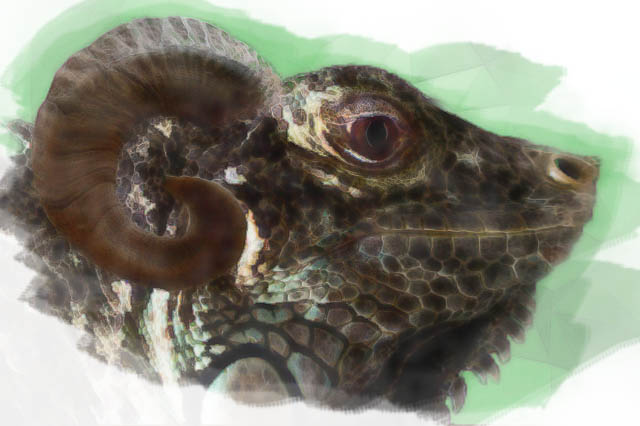Ivory-scaled kudu
The ivory-scaled kudu is a species of Kudu (wingless dragon) native to the extensive grasslands of Aralun. Its name is often shortened to ivory kudu.
More powerful than cows and of a more docile and gentle nature as long as it is not provoked, the ivory kudu is used by many people as a beast of burden by many people on Aralun.
Basic Information
Anatomy
The ivory kudu is about the size of a cow. They have a typically draconic wedge-shaped head, with two wide curled horns growing at the temples. Unlike most other kudu species that boast only small nostrils, ivory kudus have wider muzzle and nostrils, no doubt contributing to their amazing sense of smell. Their neck is relatively short and thick, recalling more that of a chameleon than a dragon. They have big round eyes ranging from yellows to greens and browns in colour and they have no visible ears. Their four legs end with four-toed feet so typical of members of the draconae family, though the ivory kudu lacks the claws of the dragon species. The ivory kudu also boast a thick, powerful tail that is usually close to the same length as their body. Their soft, delicate skin can range in colour from whites, tans and creams to yellows and browns and even black. It can be plain or sports markings such as spots, stripes or random splotches of colours. They are also covered in thick, strong scales which are translucent and usually cream or ivory in tone, giving this kudu its name.
Genetics and Reproduction
These creatures are very gentle, but their personal space is fiercely defended. They are diurnal animals, active mainly during sunlight hours. They mate once a year and bond with one or two partners throughout life.
Ecology and Habitats
The kudu's natural habitat are plains and grasslands in the centre of Aralun though they have proved to be extremely adaptable.
Dietary Needs and Habits
They're omnivores, their primary diet consisting of grass, shrubs and berries though the ivory kudus - just as any other kudu species - have been known to scavenge carcasses from time to time. Their relatively large mouths, flat teeth and long tongue are ideal for eating grass and berries.
Additional Information
Perception and Sensory Capabilities
The ivory kudu's most dominant sense is sight, having inherited their draconaean ancestors' telescoping sight - something that is extremely useful to them on the wide open plains of their Aralun homeland. Second to their sight is their sense of smell, with the ivory kudu able to scent out food or danger up to 3 miles away given the right wind condition. Unlike dragons though, most kudus are unable to use magic although some researchers have claimed ivory kudus to be the most magically-sensitive out of the 14 kudu species. They make sounds ranging from relatively high pitched to low pitched and have a extremely large range of sounds they make to indicate discoveries, dangers and otherwise communicate with each other. As with most other species of the draconae family, their scales are naturally magic-absorbent thus making even the most powerful of spells aimed at them less effective.





Comments